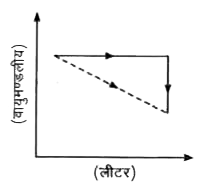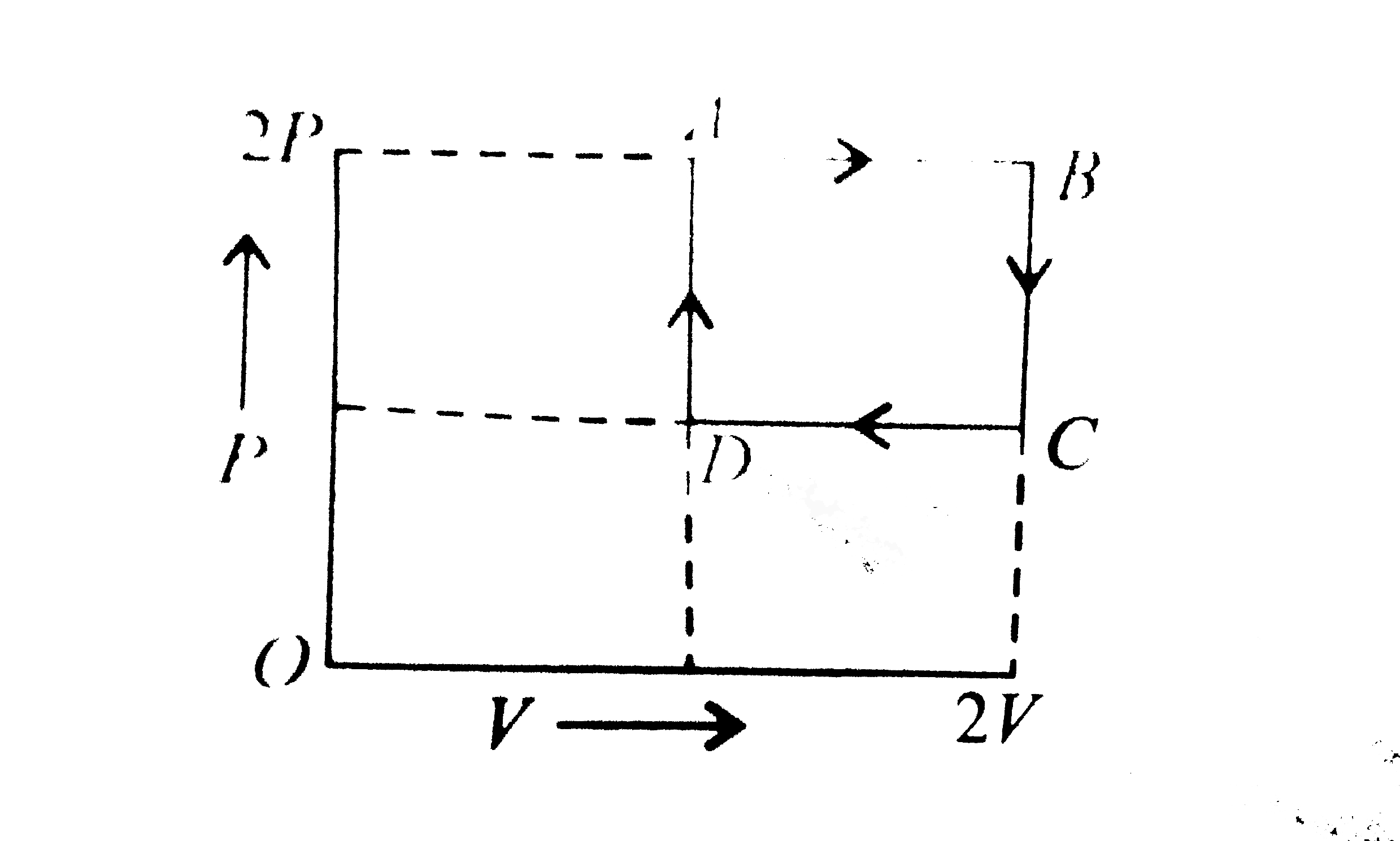For an ideal gas, consider onlyp-V work in going from an initial state X to the final state Z. The final state can be reached by either of the two paths shown in the below figure. Which of the following choices ar correct? [Take ΔS as change in entropy and was work done.]
![For an ideal gas, consider onlyp-V work in going from an initial state X to the final state Z. The final state can be reached by either of the two paths shown in the below figure. Which of the following choices ar correct? [Take Delta S as change in entropy and was work done.]](https://d10lpgp6xz60nq.cloudfront.net/physics_images/BRL_JEE_MN_ADV_CHE_XI_V01_C06_E04_017_Q01.png) Solution in Malayalam
Solution in Malayalam
ΔSx→z=ΔSx→y+ΔSy→z
Wx→z=Wx→y+Wy→z
Wx→y→z=Wx→y
ΔSx→y→z=ΔSx→y
As entropy is a state function and is additive ΔSx→z=ΔSx→y+ΔSy→x
On moving from Y to Z, the work done is zero as the volume is kept constant (isochoric process)
Wx→Y→Z=Wx→Y
Topper's Solved these Questions
- CHEMICAL THERMODYNAMICS BOOK - BRILLIANT PUBLICATIONCHAPTER - CHEMICAL THERMODYNAMICS EXERCISE - LEVEL-II (Assertion-Reason Type)
18 Videos
- CHEMICAL BONDING AND MOLECULAR STRUCTUREBOOK - BRILLIANT PUBLICATIONCHAPTER - CHEMICAL BONDING AND MOLECULAR STRUCTUREEXERCISE - QUESTION (LEVEL -ll)
42 Videos
- CLASSIFICATION OF ELEMENTS AND PERIODICITY IN PROPERTIESBOOK - BRILLIANT PUBLICATIONCHAPTER - CLASSIFICATION OF ELEMENTS AND PERIODICITY IN PROPERTIESEXERCISE - QUESTIONS (LEVEL-III ( Linked Comprehension Type ))
12 Videos
Similar Questions
Assertion : Heat of neutralisation of HNO3, and NaOH is almost same as that of HCl and KOH.
Reason : Both HNO3, and HCl are strong acids and NaOH and KOH are strong bases. : if both (A) and (R) are correct and (R) is the correct explanation of(A)., If both (A) and (R) are correct, but (R) is not the correct explanation of(A)., If(A) is correct, but (R) is incorrect., If both (A) and (R) are incorrect.
View SolutionWhich of the following species are hypervalent ?
(l) ClO−4
(ll) BF3
(lll) SO2−4
(lV) CO2−3
View SolutionThe heats of formation (ΔH∘f) of the oxides of the third period, sodium to chlorine, are in kJ mol−1

Based on these data, answer the following questions
Which oxide has maximum negative heat of formation per oxygen atom?
View SolutionThe state of an ideal gas is changed through an isothermal process at temperature T0 as shown in figure. The work done by the gas in going from state B to C is double the work done by gas in going from state A to B. If the pressure in the state B is p02, then the pressure of the gas in state C is

View SolutionFor an ideal gas, consider only P-V work in going from an initial state X to the final state Z . The final state Z can be reached by either of the two paths shown in the figure. Which of the following choice(s) is (are) correct? [Take DeltaS as change in entropy and w as work done]
View Solution
As shown in figure three paths through which a gas can be taken from the state A to the state B. Calculate the work done by the gas in each of the three paths.
View SolutionAn ideal gas undergoes change in its state from the initial state I to the final state F via two possible paths as shown. Then
View Solutionएक आदर्श गैस के लिए आरम्भिक अवस्था x से अन्तिम अवस्था : तक जाने - के लिए केवल p-V कार्य का विचार करें। पर अन्तिम अवस्था : तक पहुँचने के लिए दो पक्ष हैं जिनमें से कोई भी पथ संभव है। जैसा कि रेखाचित्र में दिखाया गया है। निम्नलिखित विकल्पों में कौन विकल्प सही है/हैं?
(ΔS को एन्ट्रॉपी परिवर्तन और W को किया गया कार्य मानें)

View SolutionIn the given figure, an ideal gas changes its state from A to C by four paths. The path for which work done is least, is

View Solutionएक आदर्श गैस के लिए, आरम्भिक अवस्था से अंतिम अवस्था Z तक जाने के लिए केवल P-V कार्य का विचार करें। अंतिम अवस्था Z तक पहुँचने के लिए दो पथ हैं जिनमें से कोई भी पथ संभव है जैसा कि रेखाचित्र में दिखाया गया है। निम्नलिखित विकल्पों में कौनसा/से विकल्प सही है/हैं [ΔS को एन्ट्रॉपी बदलाव और w को किया गया कार्य मानें]

View SolutionFor an ideal gas, consider only P-V work in going from an initial state X to the final state Z. The final state Z can be reached by either of the two paths shown in the figure. Which of the following choice(s) is(are) correct? [Take ΔS as change in entropy and w as work done]

View SolutionA system is taken to its final state from initial state in hypothetical paths as shown in the figure. Calculate the work done in each case.
View SolutionThe state of an ideal gas is changed through an isothermal process at temperature T0 as shown in figure. The work done by the gas in going from state B to C is double the work done by gas in going from state A to B. If the pressure in the state B is p02, then the pressure of the gas in state C is

View SolutionThe state of an ideal gas is changed through an isothermal process at temperature T_0 as shown in figure. The work done by the gas in going from state B to C is double the work done by gas in going from state A to B. If the pressure in the state B is (p_0)/(2) , then the pressure of the gas in state C is
View SolutionFor an ideal gas, consider only p-V work in going from an initial state X to the final state Z. The final state Z can be reached by either of the two paths shown in the figure. Which of the following choice(s) is (are) correct ?
View SolutionThe state of a mole of an ideal gas changed from state A at pressure 2P and volume V follows four different processes and finally returns to initial state A reversibly as shown below in the graph. By interpreting the graph, answer the following questions.

What would be the work done in state B→C?
View Solution
